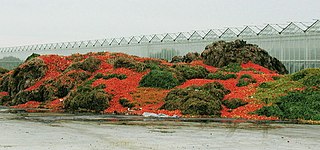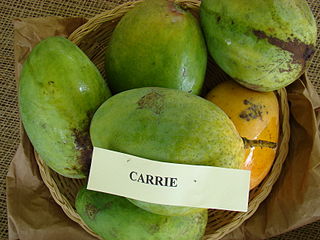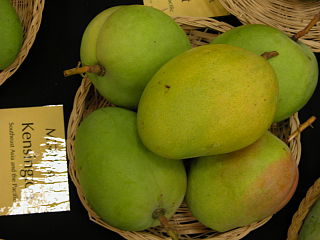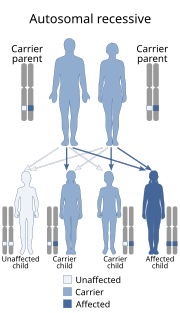
An autosome is a chromosome that is not an allosome. The members of an autosome pair in a diploid cell have the same morphology, unlike those in allosome pairs which may have different structures. The DNA in autosomes is collectively known as atDNA or auDNA.

A genetic disorder is a genetic problem caused by one or more abnormalities formed in the genome. Most genetic disorders are quite rare and affect one person in every several thousands or millions. The earliest known genetic condition in a hominid was in the fossil species Paranthropus robustus, with over a third of individuals displaying Amelogenesis imperfecta.
Parkinsonism is a clinical syndrome characterized by tremor, bradykinesia, rigidity, and postural instability. It is found in Parkinson's disease (PD)—after which it is named—dementia with Lewy bodies (DLB), and Parkinson's disease dementia (PDD), and many other conditions. A wide range of causes may lead to this set of symptoms, including neurodegenerative conditions, drugs, toxins, metabolic diseases, and neurological conditions other than PD.

Phocomelia is a condition that involves malformations of the arms and legs. Although many factors can cause phocomelia, the prominent roots come from the use of the drug thalidomide and from genetic inheritance. Occurrence in an individual results in various abnormalities to the face, limbs, ears, nose, vessels and many other underdevelopments. Although operations may improve some abnormalities, many are not surgically treatable due to the lack of nerves and other related structures.

Microcephaly is a medical condition in which the brain does not develop properly resulting in a smaller than normal head. Microcephaly may be present at birth or it may develop in the first few years of life. Often people with this disorder have an intellectual disability, poor motor function, poor speech, abnormal facial features, seizures, and dwarfism.

A birth defect, also known as a congenital disorder, is a condition present at birth regardless of its cause. Birth defects may result in disabilities that may be physical, intellectual, or developmental. The disabilities can range from mild to severe. Birth defects are divided into two main types: structural disorders in which there are problems with the shape of a body part and functional disorders in which there are problems with how a body part works. Functional disorders include metabolic and degenerative disorders. Some birth defects include both structural and functional disorders.

Mangosteen, also known as the purple mangosteen, is a tropical evergreen tree believed to have originated in the Sunda Islands of the Malay archipelago and the Moluccas of Indonesia. It grows mainly in Southeast Asia, southwest India and other tropical areas such as Colombia, Puerto Rico and Florida, where the tree has been introduced. The tree grows from 6 to 25 m tall. The fruit of the mangosteen is sweet and tangy, juicy, somewhat fibrous, with fluid-filled vesicles, with an inedible, deep reddish-purple colored rind (exocarp) when ripe. In each fruit, the fragrant edible flesh that surrounds each seed is botanically endocarp, i.e., the inner layer of the ovary. Seeds are almond-shaped and -sized.

Passiflora edulis is a vine species of passion flower that is native to southern Brazil through Paraguay and northern Argentina. It is cultivated commercially in tropical and subtropical areas for its sweet, seedy fruit, commonly called passion fruit. The fruit is a pepo, a type of berry, round to oval, either yellow or dark purple at maturity, with a soft to firm, juicy interior filled with numerous seeds. The fruit is both eaten or juiced, the juice often added to other fruit juices to enhance aroma.

Patau syndrome is a syndrome caused by a chromosomal abnormality, in which some or all of the cells of the body contain extra genetic material from chromosome 13. The extra genetic material disrupts normal development, causing multiple and complex organ defects.

A deformity, dysmorphism, or dysmorphic feature is a major abnormality in the shape of a body part or organ compared to the normal shape of that part.
Tropical sprue is a malabsorption disease commonly found in tropical regions, marked with abnormal flattening of the villi and inflammation of the lining of the small intestine. It differs significantly from coeliac sprue. It appears to be a more severe form of environmental enteropathy.

Schinus terebinthifolius is a species of flowering plant in the cashew family, Anacardiaceae, that is native to subtropical and tropical South America. It is found in these states of Brazil: Alagoas, Bahia, Espírito Santo, Mato Grosso do Sul, Minas Gerais, Pernambuco, Paraná, Rio de Janeiro, Rio Grande do Norte, Rio Grande do Sul, Santa Catarina, São Paulo, and Sergipe. Common names include Brazilian peppertree, aroeira, rose pepper, broadleaved pepper tree, wilelaiki, Christmasberry tree and Florida holly.
Neurodevelopmental disorder is a mental disorder. A narrower use of the term refers to a disorder of brain function which affects emotion, learning ability, self-control and memory and which unfolds as the individual grows. Neurodevelopmental disorders tend to last for a persons entire lifetime.
The field of neuromuscular medicine is subspecialty of neurology and physical medicine and rehabilitation. The field includes diseases that impact some part of the neuromuscular system such as the peripheral nerves, muscle motor neurons, and neuromuscular junction – the spot where nerves and muscles come together. The field encompasses issues related to both diagnosis and medical treatment of these conditions, as well as relevant rehabilitation interventions to optimize the quality of life of individuals with these conditions. This field encompasses disorders that impact both adults and children. Many of the disorders are genetic. They however can also result from an abnormal immune response, a genetic mutation, and sometimes the cause is unknown. Because they frequently have no cure, the focus is on providing improvements in the patients quality of life by reducing symptoms. A formal educational process that includes one year of fellowship training following completion of residency training in neurology or physical medicine and rehabilitation was approved by the Accreditation Council for Graduate Medical Education.

A chromosome abnormality, disorder, anomaly, aberration, or mutation is a missing, extra, or irregular portion of chromosomal DNA. It can be from an atypical number of chromosomes or a structural abnormality in one or more chromosomes. Chromosome mutation was formerly used in a strict sense to mean a change in a chromosomal segment, involving more than one gene. The term "karyotype" refers to the full set of chromosomes from an individual; this can be compared to a "normal" karyotype for the species via genetic testing. A chromosome anomaly may be detected or confirmed in this manner. Chromosome anomalies usually occur when there is an error in cell division following meiosis or mitosis. There are many types of chromosome anomalies. They can be organized into two basic groups, numerical and structural anomalies.

The post-harvest sector includes all points in the value chain from production in the field to the food being placed on a plate for consumption. Postharvest activities include harvesting, handling, storage, processing, packaging, transportation and marketing.

The 'Palmer' mango is a large, commercially grown late-season mango cultivar that originated in south Florida.

The 'Carrie' mango is a named mango cultivar that originated in south Florida, USA.

The 'Kensington Pride' mango is a named commercial mango cultivar that originated in Australia. It is sometimes called the KP, Bowen or Bowen special. It is Australia's most popular mango, accounting for over 80% of the country's annual commercial mango market. It is considered to have a distinctive flavour and aroma when compared with the Florida-bred cultivars grown by most mango-exporting countries.

Donnai–Barrow syndrome is a genetic disorder first described by Dian Donnai and Margaret Barrow in 1993. It is associated with LRP2. It is an inherited (genetic) disorder that affects many parts of the body.
















